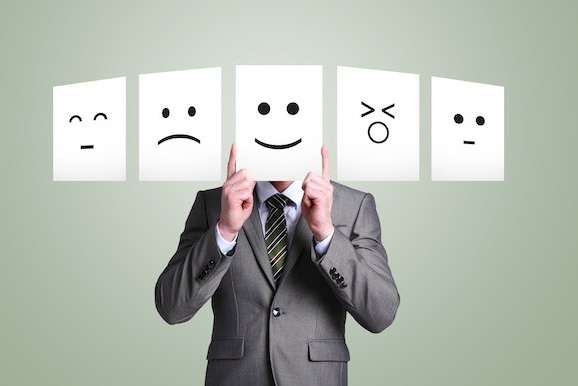


 2:17:43
2:17:43  2025-03-01
2025-03-01  1389
1389

Have you ever been stunned by someone’s reaction to something you said or did? If so, join us here.
You may have approached someone with pure intentions only to find out that what you did has provoked the other person. It’s frustrating to find a negative reaction that you didn’t expect or think you deserved.
Experiences like this can make many people lose hope in their ability to understand people. There’s a popular saying that goes: “No one can predict how other people will behave.”
If this is true, then this would be a real shame. The reason for this is that expectations are a key factor in determining behavior.
In almost every area, your behavior is largely shaped by what you expect. When you make a decision, you expect that the decision you make will be better than the previous one. When you make a change, you expect that the new situation will ultimately be better than the old one. Expectations affect even our relatively small actions. You turn on the tap because you expect the water to flow. You turn the doorknob because you expect that you can open the door.
It would be an oversimplification to say that expectation is the only factor that shapes behavior. Instinct plays a role, as does the subconscious, and habit also has an effect. However, expectation plays a major role in determining what we do and what we avoid doing.
People’s behavior is surprisingly predictable
Fortunately, human behavior is not as random as it often seems. Behavioral scientists have found that human behavior is more predictable than we think. Take opinion polls, for example. On November 4, 1984, before anyone had voted, Hamilton Jordan, Jimmy Carter’s campaign manager for the second term, received the results of the latest poll, which predicted a big loss for Carter. Jordan commented to himself, “What a funny feeling. Even though no one has voted in this country, we know we’ve lost.” The election result was exactly what the poll predicted. Ronald Reagan won a landslide victory, and polls show a remarkable ability to predict voting trends.
One of the most important studies on the predictability of human behavior was conducted by psychologist Arnold Mandel. Through careful observation of National Football League players, Mandel found that certain behaviors were strongly associated with other, somewhat different traits. When he saw an indication of some of these behaviors, he predicted with great accuracy that the player had the traits he believed were associated with that type of behavior. At one point, he could predict a lot about a National Football League player just by looking at his drawer. When he saw a clean drawer, he assumed—and usually correctly—that the player was on the offensive team, liked order and discipline, was skilled, and was somewhat reserved. When he saw a disorganized drawer, he assumed that the player was usually on the defensive team, disliked order, tended to defy rules and regulations, and was much more difficult to manage than his counterpart on the offensive team.
Mandel's predictions were remarkably accurate; Because he has developed a sound model to follow, and opinion polls, which have proven to be extremely accurate in their prediction. It is based on such models that help in prediction, and the model is a tool of the mind, as Francis Bacon, who was one of the pioneers of modern science, described it in the seventeenth century.
A great model is a useful simplification of reality. It allows you to ignore many irrelevant or weakly relevant details so that you can focus on what is important. The model shows you what to look for, helps identify useful patterns, and helps explain what you see. In other words, the model helps you avoid the unimportant aspects of a situation, so that you can better get to the heart of what you want to understand.
If models are so important in predicting people’s styles, why not develop a model that allows you to predict the likely behavior of certain types of employees, and how they like to be treated by others, in all the situations that make up our lives? The Social Style Model was developed for this purpose, and we think you will be amazed at how useful the model can be when you learn about it and use it to create better working relationships.
Just over three decades ago, industrial psychologist Dr. David Merrill developed the Social Style Model, which is the foundation of our theory of people’s styles. There are many models that have been developed to do the same thing—help people better understand and relate to others who are different from them. For many reasons, we see this model as the best for business use. After two decades of using it, it’s easier than you might think to predict employee styles, teach it to others, and conduct extensive research on it and its competing models. We’re more convinced than ever of the validity of the basic model. At the same time, we and our colleagues have developed enhancements to it that make it even more effective.
What is style? Simply put, it’s the way others perceive you to behave. However, you’ll understand style better if you use a broader definition:
A person’s habitual pattern of assertion and response is their pattern of behavior that helps predict how they will behave in working with others.
Now let's look at some of the key elements of this definition
Behavior
This theory is unique in that it focuses on behavior rather than personality. Behavior is what a person does, it is the outward expression of a person's life.
In other words, this model is concerned with body language. How fast does a person speak? How much do they gesture? How loud do they speak? How much do they change the pitch of their voice?
This model is also concerned with the words a person chooses. Does this person often ask for your opinion, or present their own point of view
In contrast, the personality of the individual includes mental, emotional and behavioral traits, and it deals with the inner self as much as it deals with the outward expression of the person's life.
This model does not concern itself with the inner world of thoughts, attitudes, feelings and values, and it does not encourage its users to search within the individuals they work with. Instead, it teaches individuals how to understand the behavior that everyone sees.
Patterns
A person's style depends on the behavioral patterns he or she performs. A pattern is a set of traits that form an integrated and cohesive entity, although it is possible to understand and predict the styles; because there are certain behaviors that go together, and the behaviors that are associated with a certain behavioral pattern are connected to each other and have an objective unity.
It is not enough to understand each behavior separately; you must know the patterns, in order to identify the person. As the famous federal judge, Learned Hand, said: “Human life is like a piece of cloth, a woven fabric of some kind. If you separate one thread and look at it separately, you not only distort the cloth, but you misjudge its value.”
When you see someone using behaviors that fit into a pattern, you can guess at other behaviors that are part of the same pattern, and as Mandel did, you can predict unobserved behavioral characteristics based on some of the behaviors you have observed. Understanding patterns is so important that Mary Lynn Ferguson, author of Brain/Mind Bull and editor of The Aquarian Canspiracy, says: “Perhaps the greatest learning disability is the inability to understand relationships or to infer meaning.”
Habit
A person’s style is determined by the behaviors that occur from habit, not by occasional behaviors. Style is the things that a person does over and over again, day after day, over a long period of time. Style is the things you do without conscious thought. Habitual behaviors are called second nature because we often rely on them instinctively—like stepping on the brakes when a car in front of us suddenly slows down. Because the behaviors associated with your style are so habitual, they seem natural and feel comfortable. This is why your style is referred to as your comfort zone.
Most of our behavior is habitual, even in our relationships with others. People are not robots that repeat the same behavior over and over again without any change. They do behave in the same way repeatedly.
Many people don’t believe this, but think about it. Don’t the people in your department have behavioral tendencies that almost everyone in management is aware of? For example, when you read the following list: Fill in each blank with the name of a person who fits these descriptions:
- ... Predicting Likely Behavior
When we say that people are highly predictable: we do not mean that you can predict every move a person makes, nor do we mean that you can be certain of a person’s reaction. When dealing with people, there are no certainties – there are probabilities – and by probability we mean the most likely to happen, so when we predict something about people we avoid words like… whenever, always, never. Instead, we rely on (usually), often, tends to, probably, rarely, and so on, but you have to understand that we are talking about probabilities, not certainties.
There are some who do not believe much in predictions that represent only probabilities; they want something more specific, and yet when predicting what a person’s reaction will be, we cannot be absolutely certain of anything.
We have to be grateful for this uncertainty, because without it, and without spontaneity in our relationships with others, we would lose much of the joy of living. Moreover, if everyone went through life like a robot and programmed, we would lose one of the precious gifts of human behavior: the freedom of human behavior.
We believe you will enjoy the improvements in your relationships when you act on strong probabilities. As James Thurber says, “A handful of probabilities is worth a pound of guesswork.”
Reality Of Islam |
|

A new chip-

A large inf

Choosing th

A new NURBS
 9:3:43
9:3:43
 2018-11-05
2018-11-05
10 benefits of Marriage in Islam
 7:5:22
7:5:22
 2019-04-08
2019-04-08
benefits of reciting surat yunus, hud &
 9:45:7
9:45:7
 2018-12-24
2018-12-24
advantages & disadvantages of divorce
 11:35:12
11:35:12
 2018-06-10
2018-06-10
 6:0:51
6:0:51
 2018-10-16
2018-10-16
 5:57:34
5:57:34
 2023-03-18
2023-03-18
the happy life of mankind requirement
 6:36:36
6:36:36
 2022-01-25
2022-01-25
 8:39:51
8:39:51
 2022-09-23
2022-09-23
 9:30:2
9:30:2
 2021-11-12
2021-11-12
 7:0:55
7:0:55
 2022-05-17
2022-05-17
 10:35:40
10:35:40
 2022-05-26
2022-05-26
 9:39:36
9:39:36
 2022-12-28
2022-12-28
 5:41:46
5:41:46
 2023-03-18
2023-03-18
| LATEST |